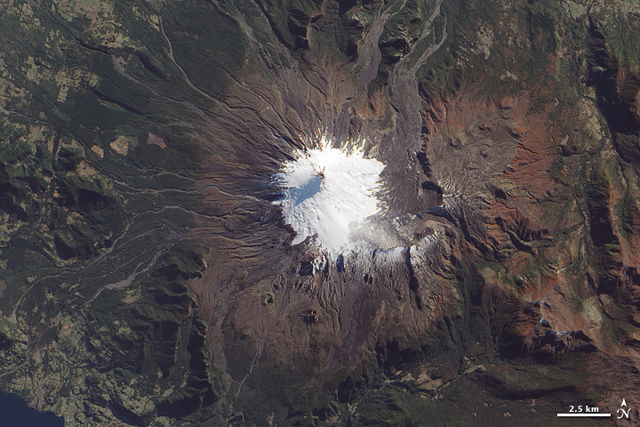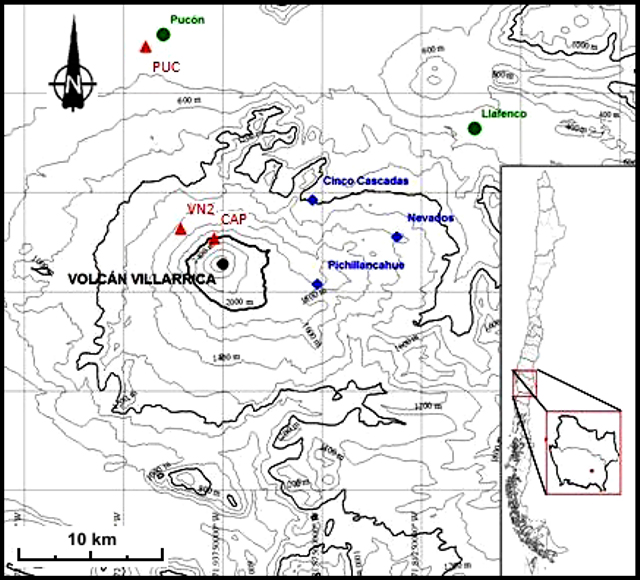Report on Villarrica (Chile) — October 2010
Bulletin of the Global Volcanism Network, vol. 35, no. 10 (October 2010)
Managing Editor: Richard Wunderman.
Edited by Paul G. Kimberly.
Villarrica (Chile) Nearly continuous gas plumes emitted from long-lived lava lake through October 2010
Please cite this report as:
Global Volcanism Program, 2010. Report on Villarrica (Chile) (Kimberly, P.G., and Wunderman, R., eds.). Bulletin of the Global Volcanism Network, 35:10. Smithsonian Institution. https://doi.org/10.5479/si.GVP.BGVN201010-357120
Villarrica
Chile
39.42°S, 71.93°W; summit elev. 2847 m
All times are local (unless otherwise noted)
During April-October 2010, nearly continuous gas plumes from Villarrica (figures 26 and 27), sometimes containing small amounts of ash, occasionally rose higher than 700 m above the crater rim. Tremor occurred, as well as frequent incandescence at night. During that time, there were 118 thermal alerts derived from the Hawai'i Institute of Geophysics and Planetology Thermal Alerts System (MODVOLC). Activity through April 2010 consisted of steam emanating from the crater punctuated by periods of Strombolian activity from the lava lake, which has been observed in the majority of eruptions since 1996; however, bursts of lava did not rise above the crater rim (BGVN 35:04).
 |
Figure 27. A NASA Earth Observatory image of Villarrica captured on 15 May 2010 by the EO-1 satellite. Courtesy of NASA Earth Observatory. |
During April, Observatorio Volcanológico de los Andes del Sur-Servico Nacional de Geologia y Mineria (OVDAS-SERNAGEOMIN) reported that the level of the lava lake rose slightly, gas emissions increased, and incandescence at night was more frequent. Seismicity also increased, with a total of 165 seismic events, of which 158 were tremors. The Alert Level was raised from "Green Level 1" to "Green Level 2" (out of a 3-color, 8-level scale). On 10 May, the surface of the spattering lava lake was ~100 m below the crater rim.
There was a slight increase in volcanic tremor through June, with a gradual decline after 26 June. Around this time, OVDAS-SERNAGEOMIN suggested that an unspecified decrease in the height of the lava lake was related to this decline in seismicity. From 9-22 July, tremor detected by the VN2 seismic station, 4 km NW of the summit, increased (figure 26). The events were located at depths of 6-10 km below the summit, except two that occurred 6 km S of the crater.
Throughout August 2010, most of the 485 seismic events recorded were long period; the largest of which was an M 2.1 located on the E edge of the caldera. During 13-15 August, slight increases in seismicity were correlated with increases in the shape and height of the steam plume emitted from the summit crater.
Seismicity decreased during September 2010, with a total of 161 seismic events recorded. On 4 September, a diffuse ash plume, possibly containing steam and gas, drifted NE. Seismicity increased significantly in October, totaling 1,874 long-period events. According to Projecto Observación Visual (POVI), ash plumes observed on 10 and 24 October and 1-2 November rose to altitudes of 3.7-4.6 km and drifted NE.
Geological Summary. The glacier-covered Villarrica stratovolcano, in the northern Lakes District of central Chile, is ~15 km south of the city of Pucon. A 2-km-wide caldera that formed about 3,500 years ago is located at the base of the presently active, dominantly basaltic to basaltic-andesite cone at the NW margin of a 6-km-wide Pleistocene caldera. More than 30 scoria cones and fissure vents are present on the flanks. Plinian eruptions and pyroclastic flows that have extended up to 20 km from the volcano were produced during the Holocene. Lava flows up to 18 km long have issued from summit and flank vents. Eruptions documented since 1558 CE have consisted largely of mild-to-moderate explosive activity with occasional lava effusion. Glaciers cover 40 km2 of the volcano, and lahars have damaged towns on its flanks.
Information Contacts: Projecto Observación Visual (POVI) (URL: http://www.povi.cl/); Observatorio Volcanológico de los Andes del Sur-Servico Nacional de Geologia y Mineria (OVDAS-SERNAGEOMIN), Avda Sta María No. 0104, Santiago, Chile (URL: http://www.sernageomin.cl/); Hawai'i Institute of Geophysics and Planetology (HIGP) Thermal Alerts System, School of Ocean and Earth Science and Technology (SOEST), Univ. of Hawai'i, 2525 Correa Road, Honolulu, HI 96822, USA (URL: http://modis.higp.hawaii.edu/); Buenos Aires Volcanic Ash Advisory Center (VAAC), Servicio Meteorológico Nacional-Fuerza Aérea Argentina, 25 de mayo 658, Buenos Aires, Argentina (URL: http://www.smn.gov.ar/vaac/buenosaires/productos.php); Jesse Allen and Robert Simmon, NASA Earth Observatory (URL: http://earthobservatory.nasa.gov/).


